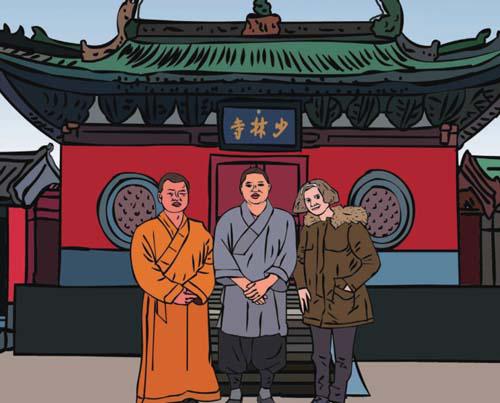Birthplace of Kungfu
2018-07-16ByJacquelineMiller
By Jacqueline Miller
Summer is tourism season, and many foreigners flock to see Beijings historic sights and Shanghais sparkling lights, and maybe even the Terracotta Warriors in Xian, capital of northwest Chinas Shaanxi Province. But another attraction merits mention—the Shaolin Monastery, a magnet for kungfu aficionados. Think Kung Fu Panda, Jet Li and Bruce Li—kungfu counts among Chinas most popular cultural exports to the West, and Westerners appear to have an ongoing love affair with it.
Kungfu, or Chinese martial arts, includes hundreds of fighting styles and different classification methods, with the most famous perhaps being the differentiation between “Northern Kicks” and“Southern Fists.”
My Chinese boyfriend loves kungfu movies, and said that when he was a child he used to watch them during his summer and winter breaks. When I asked him why, he said kungfu is “full of feeling,” and the theme song of Jet Lis 1982 movie Shaolin Temple even brings tears to his eyes. In fact, the Shaolin Monastery in central Chinas Henan Province has its own brand of kungfu, which is why we went to visit it. The cradle and capital of kungfu, it boasts 1,500 years of history.
As luck would have it, two monks gave us a personal tour. One of them wore a slatecolored robe and did most of the talking, while the other sat by quietly in a saffroncolored garment. Both had a very solemn, other-worldly air. The one with the slatecolored robe and glittering, pebble-like eyes said kungfu should be practiced as a means to understand oneself, but many people have been misguided and study it for the wrong reasons, namely to defeat other people. He said ones biggest enemy is oneself, which reminded me of a line straight out of a movie!
When my boyfriend inquired into possibly studying kungfu at the monastery for several months—the complex has dormitories for its students—the monk replied that students in their thirties are a rarity, and that usually they are younger. In fact, we encountered some students at the complex who seemed to be in their teens, but I am not sure how studying kungfu meshes with their scholastic schedules.
Moreover, we were shown a photo of the monk with former U.S. Secretary of State Henry Kissinger and former Chinese President Jiang Zemin. Russian President Vladimir Putin and other dignitaries have also visited the monastery, and I photographed the flower-shaped stone on which group photos with famous leaders were taken. Equally impressive were the old trees within the monastery, some of which bore fingerpunch markings.
When we said goodbye to the monks, I extended my hand but they didnt shake it—my gesture was considered inappropriate, I later learned, and I should have put my palms together and bowed.
After we visited the Pagoda Forest, a UNESCO World Heritage site next to the monastery. The Pagoda Forest is hundreds of years old, a burial ground for the abbots and monks of Shaolin. A modern tomb featured a car carved in stone, probably intended for the deceased to enjoy in the afterlife!
My favorite part of the Shaolin visit was hiking to the top of Songshan Mountain, the central peak of the Five Great Mountains of China. Its summit is over 1,500 meters above sea level. On our way to the top, we saw more monks and the Dharma cave, where the founder of Zen Buddhism had meditated for nine years. There is also a marble statue of the Buddha on the hilltop built in the 1990s.
We encountered two pilgrims on our way up the mountain. Both travelers cheered us on with the Chinese words jiayou and gave us a walking stick. A Buddhist nun showed me how to clutch the walking stick correctly by grabbing it from the top. On our way down, I passed the walking stick on to an elderly lady for her journey, wondering if she had practiced kungfu in her younger years.
When I emerged from the monastery, I had arrived at the understanding that kungfu is not just about demonstrating some deft moves, but a philosophy and way of life that are cultivated both inside and outside of Shaolins walls.
